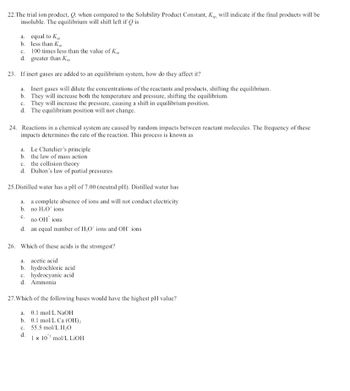
Chemistry
10th Edition
ISBN: 9781305957404
Author: Steven S. Zumdahl, Susan A. Zumdahl, Donald J. DeCoste
Publisher: Cengage Learning
expand_more
expand_more
format_list_bulleted
Question
multiple choice

Transcribed Image Text:22. The trial ion product, Q. when compared to the Solubility Product Constant, Kp, will indicate if the final products will be
insoluble. The equilibrium will shift left if Q is
a. equal to K
b. less than K
c.
100 times less than the value of Ksp
d.
greater than K
23. If inert gases are added to an equilibrium system, how do they affect it?
a. Inert gases will dilute the concentrations of the reactants and products, shifting the equilibrium.
b.
They will increase both the temperature and pressure, shifting the equilibrium.
c. They will increase the pressure, causing a shift in equilibrium position.
d. The equilibrium position will not change.
24. Reactions in a chemical system are caused by random impacts between reactant molecules. The frequency of these
impacts determines the rate of the reaction. This process is known as
a. Le Chatelier's principle
b. the law of mass action
c. the collision theory
d. Dalton's law of partial pressures
25.Distilled water has a pH of 7.00 (neutral pH). Distilled water has
a.
a complete absence of ions and will not conduct electricity
b. no H₂O ions
C.
no OH ions
d. an equal number of H₂O ions and OH ions.
26. Which of these acids is the strongest?
a. acetic acid
b. hydrochloric acid
c. hydrocyanic acid
d. Ammonia
27. Which of the following bases would have the highest pH value?
a. 0.1 mol/L NaOH
b. 0.1 mol/L Ca (OH)₂
c. 55.5 mol/L H₂O
d.
1 x 10 mol/L LiOH
Expert Solution
This question has been solved!
Explore an expertly crafted, step-by-step solution for a thorough understanding of key concepts.
Step by stepSolved in 2 steps

Knowledge Booster
Learn more about
Need a deep-dive on the concept behind this application? Look no further. Learn more about this topic, chemistry and related others by exploring similar questions and additional content below.Similar questions
- Complete each row of the table below by filling in the missing prefix. 1 | Hz 3 10 Hz %3D 1 Hz 10 Hz -6 1 Hz 10 Hz %3D -1 1 Hz 10 Hzarrow_forward30 70- 60- 50- 40- 30 20 10 0₁ 4000 Ророжа Structue nd, C₂H₂1N 3500 иде Sp 3000 2500 18 +2-20 го- 2000 1800 hu 1600 Ф тро 1400 1200 1000 800 6 Н 6 Н 9 Н 600 Уarrow_forwardDesign and construct a data table. Be sure to give the table a title.arrow_forward
- I do need help with this problem. It is multiparty. Thank you!arrow_forwardIn a particular trial, a student got a value for R of 0.083. Calculate the percent deviation of this result. Enter a number without the % sign. The percent deviation should be reported as a positive value.arrow_forwardQuality control material in the hematology laboratory is best described as: Question 3 options: A) a stable material used to establish the accuracy of an automated method and normal curve B) a stable material used to monitor the functioning of an analyzer or the performance of a process C) reagents used to perform preventative maintenance D) materials tested to develop a normal reference rangearrow_forward
arrow_back_ios
arrow_forward_ios
Recommended textbooks for you
 ChemistryChemistryISBN:9781305957404Author:Steven S. Zumdahl, Susan A. Zumdahl, Donald J. DeCostePublisher:Cengage Learning
ChemistryChemistryISBN:9781305957404Author:Steven S. Zumdahl, Susan A. Zumdahl, Donald J. DeCostePublisher:Cengage Learning ChemistryChemistryISBN:9781259911156Author:Raymond Chang Dr., Jason Overby ProfessorPublisher:McGraw-Hill Education
ChemistryChemistryISBN:9781259911156Author:Raymond Chang Dr., Jason Overby ProfessorPublisher:McGraw-Hill Education Principles of Instrumental AnalysisChemistryISBN:9781305577213Author:Douglas A. Skoog, F. James Holler, Stanley R. CrouchPublisher:Cengage Learning
Principles of Instrumental AnalysisChemistryISBN:9781305577213Author:Douglas A. Skoog, F. James Holler, Stanley R. CrouchPublisher:Cengage Learning Organic ChemistryChemistryISBN:9780078021558Author:Janice Gorzynski Smith Dr.Publisher:McGraw-Hill Education
Organic ChemistryChemistryISBN:9780078021558Author:Janice Gorzynski Smith Dr.Publisher:McGraw-Hill Education Chemistry: Principles and ReactionsChemistryISBN:9781305079373Author:William L. Masterton, Cecile N. HurleyPublisher:Cengage Learning
Chemistry: Principles and ReactionsChemistryISBN:9781305079373Author:William L. Masterton, Cecile N. HurleyPublisher:Cengage Learning Elementary Principles of Chemical Processes, Bind...ChemistryISBN:9781118431221Author:Richard M. Felder, Ronald W. Rousseau, Lisa G. BullardPublisher:WILEY
Elementary Principles of Chemical Processes, Bind...ChemistryISBN:9781118431221Author:Richard M. Felder, Ronald W. Rousseau, Lisa G. BullardPublisher:WILEY

Chemistry
Chemistry
ISBN:9781305957404
Author:Steven S. Zumdahl, Susan A. Zumdahl, Donald J. DeCoste
Publisher:Cengage Learning

Chemistry
Chemistry
ISBN:9781259911156
Author:Raymond Chang Dr., Jason Overby Professor
Publisher:McGraw-Hill Education

Principles of Instrumental Analysis
Chemistry
ISBN:9781305577213
Author:Douglas A. Skoog, F. James Holler, Stanley R. Crouch
Publisher:Cengage Learning

Organic Chemistry
Chemistry
ISBN:9780078021558
Author:Janice Gorzynski Smith Dr.
Publisher:McGraw-Hill Education

Chemistry: Principles and Reactions
Chemistry
ISBN:9781305079373
Author:William L. Masterton, Cecile N. Hurley
Publisher:Cengage Learning

Elementary Principles of Chemical Processes, Bind...
Chemistry
ISBN:9781118431221
Author:Richard M. Felder, Ronald W. Rousseau, Lisa G. Bullard
Publisher:WILEY